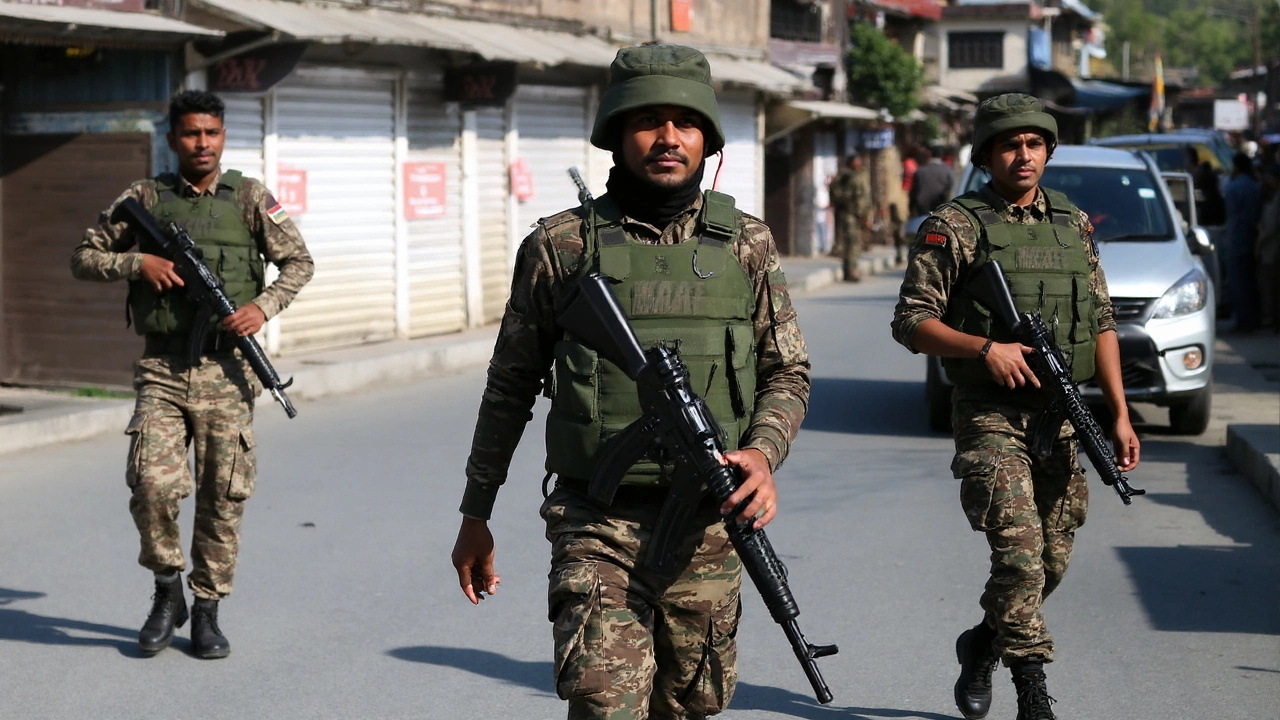At 1:05 am on May 7, the Indian Air Force started a 25-minute strike it called Operation Sindoor—nine targets across Pakistan and Pakistan-administered Kashmir, hit with precision missiles and guided bombs. It was India’s deepest reach inside Pakistani territory since 1971. The trigger? A brutal attack two weeks earlier near Pahalgam in Indian-administered Jammu and Kashmir that killed more than two dozen civilians, most of them Hindu tourists. In a region where crises rarely stay contained, the sequence was depressingly familiar—and still dangerous.
How the crisis started, and the four-day slide to the brink
The spark came on April 22 with a deadly assault near Pahalgam. Indian officials said 26–27 civilians were killed, including one Nepalese national. A shadowy group called The Resistance Front (TRF)—long described by Indian security agencies as a front for Lashkar-e-Taiba, the Pakistan-based terror organization—appeared to claim responsibility online, then reversed course and blamed “coordinated hacking” by Indian agencies. Islamabad went further, calling the attack a “false flag.” Neither the claim nor the denial could be independently verified. What was clear was the body count and the anger.
New Delhi moved fast. The government publicly held Pakistan responsible and announced a suspension of the Indus Waters Treaty (IWT)—the 1960 World Bank–brokered agreement that divides the Indus river system between the two countries. It also closed airspace to Pakistani carriers, and Pakistan reciprocated. Airports in northern and western India paused operations for days, and flight cancellations rippled across the region. The message was political and practical: India was prepared to raise costs far beyond Kashmir.
Then came the night of May 7. India said its Rafale fighters fired SCALP cruise missiles and dropped Hammer precision-guided munitions on nine locations in Pakistan’s Punjab province and in Pakistan-administered Azad Jammu & Kashmir. Indian officials described the sites as militant infrastructure—training areas, launch pads, and stores. They claimed more than 100 militants were killed. Pakistan countered that 31 civilians, including women and children, died in the strikes. Neither figure could be independently confirmed, and both capitals doubled down on their own versions.
What happened next followed a grim pattern. Troops traded fire along the Line of Control (LoC). Diplomats were pulled back. Airspace stayed restricted. Fear of escalation ran high. This crisis burned hot but brief—four days, May 7 to 10—before the guns fell largely silent. By late July, India’s defense minister told parliament operations had stopped once India judged its political and military objectives achieved. He did not spell out those objectives.
One allegation hinted at a wider arena. Senior Indian military voices accused China of providing Pakistan with “live inputs” on Indian positions during the flare-up. Pakistan’s Army Chief dismissed that claim as irresponsible and wrong. Beijing stayed quiet publicly, but the charge underlined how fast a local fight can brush against a bigger strategic rivalry.
Turkey chose a different path—visible solidarity with Pakistan. Ankara’s foreign and defense ministers met their Pakistani counterparts, and both sides talked up deeper defense industrial ties, including work on aviation and drones. In a crisis measured in minutes and miles, the subtext was about supply chains, joint projects, and capability over time.
The immediate costs were more mundane but widely felt. India shut 27 airports in the north and west through May 10 and canceled more than 430 flights. International carriers including Lufthansa, KLM, Singapore Airlines, and Thai Airways rerouted Europe–Asia services, adding fuel burn, delays, and missed connections. For travelers, the fallout felt like the 2019 post-Balakot disruptions all over again.
- April 22: Deadly attack near Pahalgam kills 26–27 civilians; blame and counter-blame start.
- Late April–early May: India suspends participation in the Indus Waters Treaty framework; both sides close airspace to each other; airports in northern and western India restrict operations.
- May 7 (01:05–01:30 IST): India launches Operation Sindoor—nine targets struck with missiles and precision bombs in Pakistan and Pakistan-administered Kashmir.
- May 7–10: Exchanges of fire along the LoC; diplomatic downgrades; commercial aviation disrupted.
- Late July: India says operations ended after objectives were met; specific aims remain undisclosed.
The shadow war over narratives ran alongside the shooting. The TRF’s flip—from claiming the Pahalgam attack to alleging its channels were hacked—fit the pattern of deniable groups and contested online fingerprints. Islamabad’s “false flag” charge is a standard line in South Asian crises. New Delhi’s rebuttal is equally familiar: the attack fits the profile of groups it says operate with support from across the border. None of these lines are new, but they now spread instantly, and they harden positions before facts settle.

Why this flare-up matters: water, air routes, and an old dispute that keeps mutating
Start with water. The Indus Waters Treaty is one of the world’s most durable water agreements. It gives Pakistan rights over the western rivers—Indus, Jhelum, Chenab—and India rights over the eastern trio—Ravi, Beas, Sutlej—while allowing India limited uses on the western rivers for hydropower and irrigation within tight design rules. New Delhi’s announcement of a suspension was a serious signal, even if lawyers point out the treaty has no simple “off switch.” In practice, a suspension without major engineering to divert or store flows is more political than physical. Still, process matters: halting joint meetings, fast-tracking projects on the western rivers, and leaning on design margins can squeeze trust and spark new technical disputes.
Then the skies. India’s closure of 27 airports and more than 430 flight cancellations in a few days underscored how quickly a South Asian crisis hits global corridors. Europe–Southeast Asia and Europe–Australia routes often thread near Pakistani and Indian airspace to balance headwinds and fuel. When carriers like Lufthansa, KLM, Singapore Airlines, and Thai Airways rerouted, costs rose and schedules slipped. During the 2019 Balakot standoff, detours added up to an hour on some flights and millions in extra fuel bills. This time was shorter but showed the same vulnerability: a border skirmish can become a network problem for airlines from Frankfurt to Singapore.
Now, the military balance. India’s use of Rafales with SCALP missiles and Hammer kits showed a maturing precision-strike toolkit. The 25-minute window—tight, pre-planned, and at night—looked designed to achieve surprise and limit exposure to Pakistani air defenses. Pakistan’s side of the ledger includes its own air defense network and fighters that, in past crises, have shown they can contest Indian strikes and impose costs. Both militaries have practiced for this—quick strikes, quick counters, and political control over escalation. The trouble is, precision still kills, and even a single miscalculation can push nuclear-armed rivals into a spiral.
Set this against history. Kashmir has driven wars (1947–48, 1965), a crisis alongside a wider war (1971), a limited high-altitude conflict (Kargil 1999), and airstrikes with cross-border interceptions (2019). After India revoked Jammu and Kashmir’s special status in August 2019, the LoC quieted for a while following a 2021 reaffirmation of the ceasefire—until it didn’t. The 2025 exchanges broke that calm and showed that militant violence inside Kashmir can still pull the two states into the open.
Domestic politics add heat. In India, any mass-casualty attack on civilians, especially pilgrims or tourists, brings intense pressure to respond. In Pakistan, civilian casualties from Indian strikes and sovereignty issues drive public anger and force the military to show resolve. That dance—action, counteraction, and face-saving offramps—has defined crisis management in South Asia for years.
China and Turkey were the loudest external echoes this time. India’s allegation that China fed “live inputs” to Pakistan drew a sharp denial from Rawalpindi. Even without direct involvement, Beijing’s wider rivalry with New Delhi—border tensions in the Himalayas, infrastructure in Pakistan, and defense technology flows—hangs over every India–Pakistan flare-up. Turkey’s embrace of Pakistan fits a longer arc of defense ties, including cooperation on drones and aviation. Each new partnership tweaks the military balance at the margins, and over time those margins matter.
Information warfare is now part of the terrain. Claims of hacked channels, instant denials, doctored visuals, and dueling casualty numbers shaped this crisis as much as artillery did. Open-source imagery shared by independent analysts online appeared to show fresh blast marks at some alleged target areas, but without on-the-ground access and official transparency, the public is left parsing pixels and statements. That fog favors hardliners on both sides.
For people in Kashmir, the consequences were immediate: more checkpoints, longer shutdowns, and the familiar fear that follows every bomb and raid. Tourism—one of the few bright spots in recent years—took a hit after the Pahalgam killings. The pilgrimage season loomed under heavier security. Families near the LoC braced again for shells and sudden evacuations.
Three themes to watch now:
- Water leverage: Does India move beyond symbolism on the Indus? Steps like fast-tracking disputed hydropower designs or delaying data sharing could reopen technical fights that usually sit below the political radar.
- Aviation normalization: Airlines will return to preferred routes if airspace stays open, but insurers and schedulers remember recent shocks. A single alert notice can send them back over the long way around Central Asia.
- Backchannel guardrails: Crises in 2002, 2019, and now 2025 ended short of the worst. That usually means quiet talks through trusted intermediaries. If those lines fray, the next clash could run longer.
There’s also the legal gray zone around the Indus deal. Even if a treaty can’t be “paused” with a press note, signaling withdrawal from routine cooperation—technical talks, dispute boards, inspections—has its own bite. Water lawyers say the IWT’s real strength has always been practice: regular meetings, data shared on time, problems solved early. Break that rhythm and small design disagreements become political fights fast.
Militarily, the lesson for planners is familiar. Precision air power can hit deep and fast, but it doesn’t settle the underlying dispute. If militant networks regenerate, another attack can restart the cycle. If politics cool the LoC, even a modest thaw helps civilians on both sides live normal lives for a while. Deterrence works until it doesn’t, and both capitals know first moves are easier than controlled exits.
For the wider world, a 25-minute strike in the Himalayas matters because of what flies above and flows below. Air corridors link Europe and Asia in ways that are easy to take for granted until they kink. Rivers that cross a hard border bind economies together whether politicians like it or not. That’s why the toughest lines in this crisis were not the missiles or the artillery, but the ones about water and airspace. Both are hard to weaponize without blowback.
Strip it to its core and this is what happened: a mass-casualty attack on civilians; a rapid Indian reprisal across the border; four days of exchange under nuclear shadow; parallel battles over narratives and allies; and a return to tense quiet. The dispute over Kashmir—rooted in 1947, shaped by 1999, rebooted in 2019—still has the power to pull two rivals back to the edge. The latest flare-up didn’t settle anything. It did, however, offer a blunt reminder of how fast the India-Pakistan conflict can scale, and how much beyond the battlefield it can affect.








Write a comment